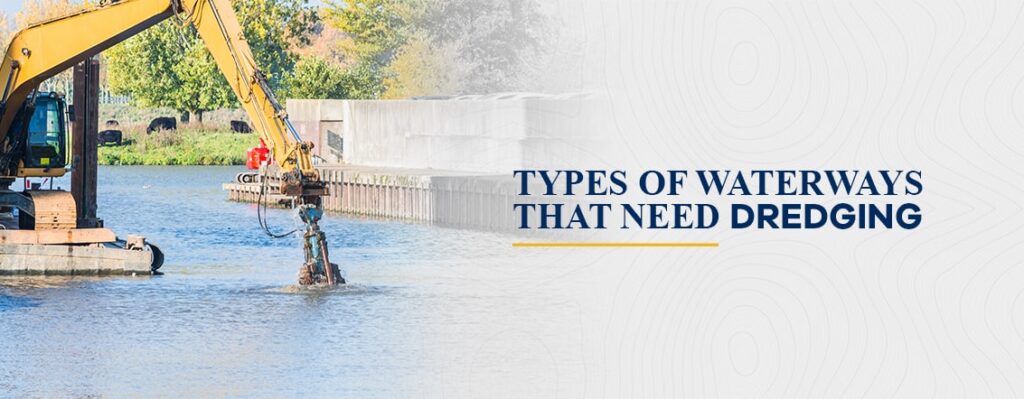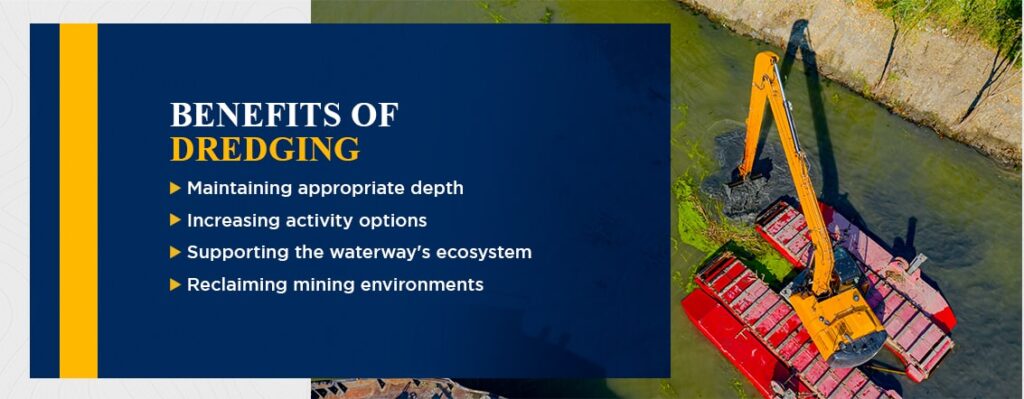From golf courses and national parks to homeowner’s associations and local governments, those in charge of waterways need to incorporate dredging in regular maintenance. Dredging is a significant part of waterway care for just about every body of water. Rivers, ponds, lakes and even beaches need to be dredged to retain their appearance, prevent algae problems and support more wildlife.
While they all need dredging, the process looks a little different for each type of waterway. Let’s look a little closer at dredging and how it affects these different types of waterways.
Why Dredging Waterways Is Crucial
Every waterway follows a natural process, collecting sediment and changing its characteristics. This sediment could come in the form of natural materials, like soil, rocks, clay and plant or animal matter. It could also come from human-made debris such as construction materials and refuse. Dredging removes both kinds of debris.
If the debris involves toxic or otherwise damaging materials that humans have left behind, dredging can remove these substances and keep them from harming the wildlife. Even natural sediment must be dredged if you want to keep the waterway in good condition. Natural sediment can cause the waterway to become shallow and swampy and eventually dry up as part of the natural process. It could also result in smelly, unpleasant algal blooms. Dredging stops this process.
If your waterway has a functional purpose, such as supporting commercial ships or holding fish for recreational activities, dredging is crucial. It helps to retain the usefulness of the waterway by supporting wildlife and the appropriate depth.
Benefits of Dredging
There are many advantages of dredging a waterway, such as:
- Maintaining appropriate depth: Dredging ensures that the bottom of the waterway is low enough to allow ships to pass by safely. Water traffic can move more easily and with greater confidence. Plus, you can widen the waterway for larger boats and more options.
- Increasing activity options: In many instances, waterways are a source of recreational and commercial activities, like beachgoing, fishing and boating. With cleaner waters, more wildlife and well-supported coastlines, these activities are more enjoyable and available, creating a great opportunity for tourism and attractions.
- Supporting the waterway’s ecosystem: Aquatic environments can be negatively affected by the buildup of silt and sediment. Dredging removes this sediment, leaving more oxygen in the water for fish to use and providing more space for them to thrive. A dredged waterway also supports all the other animals that depend on the fish. When contaminated silt is removed, pollutants are also removed, providing a healthier environment for wildlife. Uncontaminated silt can even be deposited in other areas, like wetlands or the coastline, to work as fertilizer and support plant growth.
- Reclaiming mining environments: After mining, the land that was mined must be restored to an environmentally supportive state. Dredged silt can be turned into topsoil when mixed with other materials such as clay and compost.
Types of Waterways That Need Dredging
Dredging is a suitable process for a variety of waterways. See if an area you manage contains waterways like these to determine if dredging is a potential solution:
Lakes
Lakes follow a natural process that involves drying up and starting eutrophication. In eutrophication, the sediment pulls oxygen from the water, harming wildlife and accelerating plant growth. Silt continues to accumulate and eventually turns the lake into a swamp. Dredging the lake prevents this process.
Dredging a lake also keeps it from accumulating algae, which can be a big deterrent for guests of a golf course, residents in a neighborhood or swimmers. It prevents the eutrophication process and algal blooms, keeping the lake in the condition you want it, great for recreational activities and property aesthetics.
Ponds
A pond is often used on a property as an attractive focal point or aesthetic addition. If it is not dredged, it can become an unpleasant eyesore with a strong smell. Because many rivers and streams feed into ponds, they also create the perfect space for sediment from those waterways to collect. As that sediment builds up, marine and plant life can struggle, and the pond can start to eutrophicate, just like lakes.
Dredging the pond, whether human-made or natural, keeps the process at bay while creating a clean and pleasant pond.
Beaches
Coastal erosion can be a problem for beaches, reducing the amount of available sand and coastline for people to use. The right method of dredging can counteract this process. Traditionally, the sediment pulled up from a waterway is deposited offshore, often as fertilizer. On beaches, the silt can be redeposited into the sediment system by dumping in areas without much nourishment. These areas are often affected by erosion associated with hard engineering structures such as groins and jetties.
In short, dredging can support the beach’s coastline, providing more recreational space and opportunities to attract guests. And you’ll support the proliferation of exciting marine animals.
Rivers
Rivers also require dredging for several reasons. They’re often the source of unwanted human-made debris, and cleaning them up creates a more environmentally friendly river without toxic materials leaching into the water. River water often feeds into other bodies of water, like lakes, so supporting the cleanliness of the water can help all of the connecting waterways stay healthy, too.
Dredging a river also deepens it, providing easier passage for a variety of water vessels, from commercial ships to recreational boats. It makes the waterway safer and provides a more reliable route. Other benefits of a dredged river include the advantage it provides for recreational fishing and activities like canoeing and boating. The water is cleaner and safer for everyone.
One challenge that comes from dredging rivers is the need to avoid damaging the riverbanks. Some dredgers are particularly damaging to the ground they move over and can cause erosion. Reckless dredging can also lead to silt, potentially containing toxins, being kicked up into the water and causing further damage. To avoid these problems, the right dredger must be used with portability and environmentally friendly designs.
Learn More About Dredging With GeoForm International
Dredging is a necessary component of managing a waterway, and the right tools are an integral part of doing so correctly and affordably. To help you get there, we have a few tools that are up for the job, most notably, the Dino6 and Dino8:
- Dino6: The Dino6 is the ideal sediment removal system for small dredging projects, as it can maneuver into the spaces larger hydraulic dredges can’t get to. It’s good for retention ponds, sediment lakes, marinas, golf courses, home association lakes and more. Durability, affordability, efficiency and portability all come standard with the Dino6.
- Dino8: For the larger projects, there’s the Dino8. This powerful system is great for mid-sized waterways and features a range of efficient features, from a 3,000 gallon-per-minute capability to pipes that pump to farther distances. It’s still easy to use, durable and affordable.
Whatever your dredging needs are, GeoForm International can help. To speak with a skilled representative, reach out to us today!



